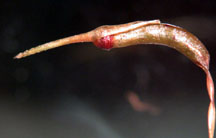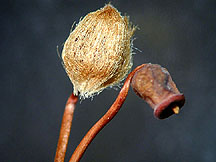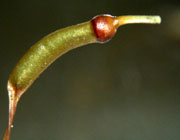


Mosses
Atrichum
 |
|
Atrichum
undulatum
|
Atrichum is a member of the Polytrichidae and like other members within this family, it has an epiphragm underneath its operculum. This feature can be seen in the picture directly below. Note that it looks like a little frisbee, or dinner plate. The little finger-like extensions attached to the epiphragm are multicellular peristome teeth.
 |
| Atrichum undulatum - note epiphragm unique to the family Polytrichidae |
If you found yourself suddenly being quizzed on the different species of Polytrichidae, could you be able to identify Atrichum? One helpful hint is to look at the calyptra. Atrichum has a smooth calyptra:
 |
|
Atrichum undulatum - note hairless calyptra |
- while all other members or the family Polytrichidae have a hairy calyptra. One such example is Polytrichum piliferum, shown in the picture below:
 |
|
Polytrichum piliferum - note the very hairy calyptra |
Another helpful hint would be to look under the calyptra. The operculum in Atrichum has a characteristic long "beak" (picture below). The rich green leaves of Atrichum are quite interesting as well. The margins of the leaves are toothed and some can contort when dry.
 |
| Atricum undulatum- calyptra-less sporangium |
There are several species within the genus Atrichum. A. selwynii, A. undulatum, and A. tenellum are the most common species of Atrichum found in Southwestern British Columbia. They can be found on mostly acidic and moist soils. They like shady forest floors, and in particular banks along waterways. The Atrichum that you find in your garden or along moist roadsides will most probably be A. undulatum.


